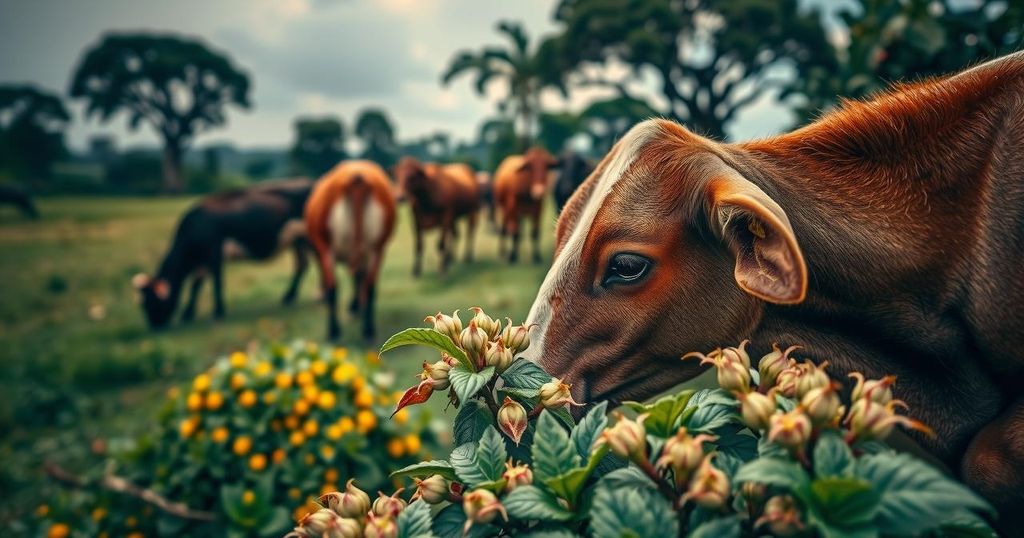Climate change is causing livestock diseases that threaten peace at the Kenya-Uganda border, where pastoral communities are facing resource scarcity due to prolonged drought. As herders migrate in search of pasture, conflicts and disease outbreaks have surged, prompting calls for joint interventions and resource-sharing agreements to stabilize the situation and promote coexistence.
The emergence of livestock diseases exacerbated by climate change is igniting tensions along the Kenya-Uganda border, particularly affecting pastoral communities reliant on livestock. Transboundary animal diseases pose a significant threat to livestock, rapidly spreading across national borders and impacting both socio-economic stability and public health. In recent decades, the Kenya-Uganda border has experienced relative tranquility since the 1973 Lokiriama Peace Accord, facilitating cross-border trade. However, ongoing drought conditions have diminished resources like pasture and water, compelling pastoralists from the Loima, Lokiriama, and Turkana West sub-counties to migrate into Uganda’s Karamoja region in search of sustenance. This migration has unfortunately led to increased conflicts, with armed bandits exploiting the vulnerable situation of the herders. Mr. Korobe Ngasike, a herder from Nawountos village, highlights the dire risk of transboundary diseases, which have been exacerbated by climatic changes. He stated, “Our search for pasture forces some of us to settle at border areas with a high burden of cattle vector-borne diseases and Peste des Petits Ruminants… and areas near Kidepo National Park that have African animal trypanosomiasis.” The introduction of these diseases is altering traditional practices among the herders, who are now reluctant to engage in counter raids to reclaim stolen livestock due to the fear of disease outbreaks. In response, community leaders have convened to propose joint interventions as articulated in their recent peace accord. Mr. Joseph Areng, Peace Building Officer at the Agency for Cross Border Pastoralists Development, stated that “joint mass livestock treatment and vaccination will not only ensure sustainable pastoralism, but also promote coexistence.” Pastoralists like Mr. Charles Ekai from Oropoi village have reported significant livestock losses due to diseases linked to tsetse flies, compounded by poor accessibility to veterinary services. The need for improved infrastructure and communication is vital, as very few solutions are currently available to aid these communities promptly. Leaders from both nations, including Turkana Governor Jeremiah Lomorukai and Uganda’s Karamoja Affairs Minister Peter Lokeris, have emphasized the importance of mutual cooperation to address the challenges at the border. Governor Lomorukai has called for the swift finalization of a Resource Sharing Agreement, deeming it crucial for socio-economic development in the region. He expressed, “The Resource Sharing Agreement is more than just a document; it is a beacon of hope for socio-economic growth and stability across our border.” Discussions underscore that peace must prevail to facilitate development and resource management effectively. Dr. Lokeris reaffirmed, “Let us bank on the peace pact as a testament to the power of unity and cooperation in overcoming emerging challenges like diseases.” The sentiments shared by community leaders and pastoralists alike reflect an urgent need for collaborative efforts to mitigate the impacts of climate change-induced diseases that threaten their livelihoods and foster greater instability in this strategically important region.
The topic of climate change and its effects on livestock management is critical in understanding the tensions along the Kenya-Uganda border. Pastoral communities depend heavily on livestock for their livelihoods, but recent climatic events have led to prolonged droughts, resulting in diminished resources. Transboundary animal diseases present a growing challenge, complicating existing socio-economic issues and threatening public health in the region. Historical contexts, such as the Lokiriama Peace Accord, are paramount as they highlight previous efforts towards fostering peace and cooperation that are now jeopardized by emerging challenges.
In conclusion, the rising tensions due to climate change-induced livestock diseases among pastoral communities along the Kenya-Uganda border reveal a complex interplay of environmental crises, socio-economic challenges, and public health concerns. The call for coordinated intervention between both nations is essential for sustainable pastoralism and the maintenance of peace. As pastoralists grapple with the repercussions of climate-driven changes, the need for infrastructure improvement, enhanced veterinary services, and mutual cooperation emerges as pivotal for safeguarding their livelihoods and ensuring community stability.
Original Source: nation.africa






